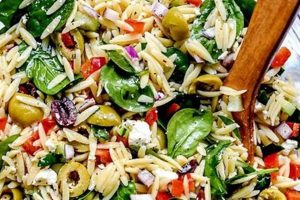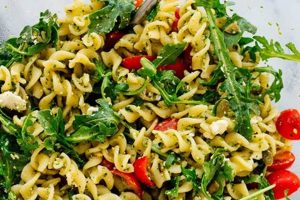This simple dish combines fresh, ripe tomatoes, fragrant basil leaves, and creamy mozzarella cheese. A classic example features sliced tomatoes layered with mozzarella and basil, drizzled with olive oil and balsamic vinegar, and seasoned with salt and pepper. Variations can include different types of tomatoes, mozzarella (such as fresh bocconcini or burrata), and additions like olives, roasted red peppers, or pesto.
The appeal lies in the fresh, high-quality ingredients and their complementary flavors and textures. The sweetness of the tomatoes, the peppery basil, and the milky mozzarella create a harmonious balance. As a light and refreshing dish, it is often served as an appetizer, side dish, or a light lunch during warmer months. Its popularity stems from its ease of preparation and the availability of its core components, particularly in Mediterranean cuisines where these ingredients are staples.
Further exploration could delve into specific variations, regional adaptations, nutritional information, optimal ingredient selection, and detailed preparation techniques. Discussions on complementary pairings, such as wine or bread, could also enhance understanding and appreciation of this culinary staple.
Tips for a Perfect Tomato Basil Mozzarella Salad
Elevating this classic dish requires attention to detail and an understanding of how each component contributes to the overall experience. The following tips offer guidance on optimizing flavor and presentation.
Tip 1: Ingredient Quality is Paramount: Opt for ripe, in-season tomatoes for the best flavor. Look for vibrant color and a fragrant aroma. Fresh mozzarella, ideally packed in water, offers a superior creamy texture compared to pre-shredded alternatives. Fresh basil leaves should be vibrant green and free from blemishes.
Tip 2: Proper Tomato Preparation: Slice tomatoes evenly to ensure consistent texture and aesthetic appeal. Heirloom tomatoes, with their varied colors and shapes, can add visual interest. Removing excess seeds and pulp can prevent the salad from becoming watery.
Tip 3: Mozzarella Handling: Allow the mozzarella to drain thoroughly before slicing or tearing. This prevents excess moisture from diluting the flavors and ensures a clean presentation. For larger mozzarella balls, tearing creates a more rustic and appealing texture than slicing.
Tip 4: Basil Technique: Tear basil leaves by hand rather than chopping them. Chopping can bruise the leaves and release bitterness. Tearing preserves the delicate flavor and aroma.
Tip 5: Seasoning Timing: Season the salad just before serving to prevent the salt from drawing out too much moisture from the tomatoes. Freshly ground black pepper enhances the overall flavor profile.
Tip 6: Oil and Vinegar Selection: Use high-quality extra virgin olive oil. A robust olive oil can add complexity to the dish. Balsamic vinegar should be of good quality, preferably aged, for a balanced sweetness and acidity.
Tip 7: Arrangement and Presentation: Arrange the salad components thoughtfully. Consider alternating layers of tomato and mozzarella, interspersed with basil leaves, for an appealing visual presentation. A drizzle of olive oil and balsamic glaze just before serving adds a final touch of elegance.
By following these tips, one can elevate a simple tomato, basil, and mozzarella salad to a truly exceptional culinary experience. The combination of fresh, high-quality ingredients and careful preparation techniques will result in a dish that is both visually appealing and bursting with flavor.
These insights provide a foundation for creating a delightful and memorable salad. Further exploration can delve into specific variations and regional adaptations.
1. High-Quality Ingredients
High-quality ingredients are essential for a truly exceptional tomato basil mozzarella salad. This dish, characterized by its simplicity, relies heavily on the freshness and flavor of its core components. The inherent quality of each ingredient directly impacts the overall taste and enjoyment. Substandard tomatoes, bland mozzarella, or bruised basil can diminish the salad’s potential, resulting in a mediocre experience. Conversely, using the finest ingredients elevates the dish to a new level of culinary delight. The interplay of ripe, juicy tomatoes, creamy, fresh mozzarella, and fragrant basil creates a harmonious balance of flavors and textures that is simply unattainable with inferior ingredients.
Consider the difference between a mass-produced, winter tomato and a vine-ripened heirloom tomato bursting with summer flavor. The latter, with its vibrant sweetness and complex aroma, contributes significantly more to the salad’s overall taste profile. Similarly, fresh mozzarella, packed in water and still holding its delicate whey, offers a far superior texture and flavor compared to pre-shredded, dry varieties. Freshly picked basil leaves, vibrant green and fragrant, provide a peppery, aromatic counterpoint to the sweetness of the tomatoes and the richness of the mozzarella. Investing in high-quality olive oil and balsamic vinegar further enhances the salad’s flavor profile, adding depth and complexity.
The impact of ingredient quality extends beyond mere taste. The visual appeal of the salad is also significantly enhanced by using vibrant, fresh ingredients. Deep red tomatoes, glistening white mozzarella, and verdant basil create a visually stunning dish that is as appealing to the eye as it is to the palate. Ultimately, the pursuit of high-quality ingredients reflects a commitment to maximizing both the culinary and aesthetic potential of the tomato basil mozzarella salad. This dedication to quality transforms a simple dish into a truly memorable culinary experience.
2. Proper Seasoning
Proper seasoning is paramount in a tomato basil mozzarella salad. This seemingly simple dish relies heavily on the balance and enhancement of its fresh ingredients. Salt, primarily, plays a crucial role, not only in enhancing the flavors of the tomatoes, basil, and mozzarella but also in drawing out their inherent sweetness and subtly altering their textures. The right amount of salt amplifies the tomato’s natural sweetness while simultaneously tempering the basil’s peppery notes and highlighting the mozzarella’s creamy richness. Over-salting, however, can mask these delicate flavors and create an unpleasant, briny taste, while under-salting leaves the salad tasting flat and underwhelming. Consider the impact of coarse sea salt versus finely ground table salt: the former provides a pleasant textural contrast and a slower salt release, while the latter dissolves quickly, providing immediate seasoning.
Beyond salt, black pepper adds a subtle layer of complexity. Freshly ground black pepper is preferred as it offers a more vibrant, pungent aroma and flavor compared to pre-ground pepper. A touch of acidity, often in the form of balsamic vinegar or a squeeze of fresh lemon juice, brightens the flavors and provides a counterpoint to the richness of the mozzarella. The quality of the vinegar or lemon juice matters significantly. A high-quality balsamic vinegar offers a balanced sweetness and tanginess, while freshly squeezed lemon juice provides a clean, citrusy note. The quantity of acid should be carefully considered, as too much can overpower the delicate flavors of the tomatoes and basil.
Mastering the art of seasoning in this context involves understanding the interplay of these elements. It requires a nuanced approach, balancing the salt, pepper, and acidity to create a harmonious flavor profile that complements, rather than overwhelms, the fresh ingredients. The timing of seasoning also plays a critical role. Salting the tomatoes slightly in advance can draw out excess moisture and concentrate their flavor. However, adding the remaining seasonings just before serving prevents the salad from becoming soggy and ensures that the flavors are at their peak brightness. Through careful attention to detail and an understanding of how each seasoning element interacts with the core ingredients, one can elevate this simple salad to a truly exceptional culinary experience.
3. Knife Skills
Knife skills play a crucial role in preparing a visually appealing and texturally pleasing tomato basil mozzarella salad. Precise cuts ensure even cooking, if applicable, and contribute to the overall aesthetic of the dish. Consistent slicing of the tomatoes and mozzarella creates a harmonious presentation and allows for even distribution of flavors. Proper knife techniques also minimize bruising and damage to delicate ingredients like basil, preserving their optimal texture and taste.
- Uniform Slicing:
Uniform slicing of tomatoes ensures even distribution of flavor and creates a visually appealing presentation. Consistent thickness allows for balanced layering and prevents some pieces from being overly seasoned while others remain bland. This is particularly important when using a variety of tomato sizes and shapes, as uniform slicing creates a sense of order and balance in the salad.
- Clean Cuts for Mozzarella:
Clean cuts, whether slicing or tearing, are essential for maintaining the mozzarella’s integrity. A sharp knife prevents the cheese from being compressed or shredded, preserving its smooth, creamy texture. Clean cuts also ensure that the mozzarella pieces hold their shape and do not become mushy or disintegrate when combined with other ingredients. This contributes to a more appealing and palatable salad.
- Handling Basil:
Basil leaves, being delicate, benefit from proper handling. Tearing or chiffonade, rather than chopping, prevents bruising and the release of bitter compounds. This preserves the basil’s vibrant green color and its delicate, peppery flavor. Chopping, conversely, can damage the cell walls of the leaves, leading to oxidation and a less appealing, darkened appearance.
- Dicing for Other Ingredients:
If additional ingredients, such as red onion or bell peppers, are included in the salad, consistent dicing ensures even distribution of flavors and textures. Uniformly sized pieces contribute to a more balanced and visually appealing salad, where each bite offers a harmonious blend of all the components. This also ensures that no single ingredient dominates the overall flavor profile.
The application of proper knife skills elevates the tomato basil mozzarella salad from a simple dish to a carefully constructed culinary creation. The precision and care taken in preparing each ingredient contribute not only to the visual presentation but also to the overall flavor and textural experience. Uniformity in slicing, clean cuts for mozzarella, and the delicate handling of basil ensure that each bite offers a balanced and harmonious blend of flavors, textures, and colors, demonstrating a thoughtful approach to preparation and an appreciation for the nuances of this classic salad.
4. Ingredient Order
Ingredient order significantly impacts the final flavor and textural profile of a tomato basil mozzarella salad. While seemingly simple, the sequence in which components are combined affects how flavors meld and textures interact. The delicate nature of basil, for example, necessitates its strategic placement. Adding basil too early, especially when salt is present, can lead to premature wilting and the release of bitter compounds. Conversely, placing it atop the salad preserves its fresh, peppery aroma and vibrant green color. Similarly, adding the dressing directly to the tomatoes can cause them to become soggy, diluting their flavor and compromising the salad’s overall texture. A more effective approach involves lightly coating the mozzarella with the dressing first, creating a protective barrier that prevents the tomatoes from becoming waterlogged. This also ensures a more even distribution of flavor.
Consider a scenario where balsamic vinegar is added directly to sliced tomatoes. The high acidity of the vinegar quickly breaks down the tomato’s cell walls, releasing excess moisture and resulting in a watery salad. If, however, the mozzarella is lightly dressed first, its surface absorbs some of the vinegar, mitigating its direct impact on the tomatoes. This allows the tomatoes to retain their structural integrity and their fresh, vibrant flavor. Furthermore, the mozzarella, being less susceptible to the vinegar’s effects, benefits from the added flavor dimension. This nuanced approach underscores the importance of understanding how different ingredients interact with each other and how their placement affects the final outcome.
Optimizing ingredient order is crucial for achieving a balanced and harmonious tomato basil mozzarella salad. It involves considering the delicate balance of flavors, textures, and the potential for unwanted interactions between components. The strategic placement of each element ensures that the salad remains fresh, vibrant, and flavorful, maximizing the culinary experience. Understanding these principles enables the creation of a salad that is not only visually appealing but also offers a delightful interplay of tastes and textures.
5. Freshness
Freshness is paramount to a successful tomato basil mozzarella salad. This dish, reliant on the natural flavors of its core components, is significantly impacted by ingredient quality. Freshness, in this context, translates to ripe, in-season tomatoes, recently harvested basil, and high-quality mozzarella, preferably stored in water. The difference between a salad made with peak-season tomatoes and one made with out-of-season alternatives is stark. Ripe tomatoes offer a burst of sweetness and juiciness, while their out-of-season counterparts often lack flavor and texture. Consider a salad made with freshly picked basil versus basil that has been stored for several days. The former offers a vibrant, peppery aroma and flavor, while the latter may exhibit wilting, discoloration, and a diminished taste. Fresh mozzarella, particularly when stored in its whey, provides a creamy, delicate texture and a clean, milky flavor. Using older mozzarella can lead to a rubbery texture and a less desirable, slightly sour taste.
The impact of freshness extends beyond individual ingredients. The interplay of these fresh components creates a synergistic effect. The sweetness of ripe tomatoes complements the peppery bite of fresh basil, while the creamy mozzarella provides a rich, unifying element. When all ingredients are at their peak freshness, this synergy is amplified, resulting in a vibrant and flavorful salad. Conversely, the use of subpar ingredients diminishes this interplay, leading to a less satisfying overall experience. Imagine biting into a salad made with mealy tomatoes, wilted basil, and dry mozzarellathe flavors are muted, the textures unappealing. This underscores the critical role freshness plays in elevating the dish.
Prioritizing freshness ensures that the tomato basil mozzarella salad reaches its full potential. The dish’s inherent simplicity demands high-quality ingredients. Freshness, therefore, becomes not merely a desirable attribute but a fundamental requirement. Understanding the impact of freshness on each component, and on the overall composition of the salad, allows for informed ingredient selection and ultimately, a more satisfying culinary experience. Compromising on freshness ultimately compromises the dish itself.
Frequently Asked Questions
This section addresses common inquiries regarding the preparation and enjoyment of tomato basil mozzarella salad.
Question 1: Can one substitute dried basil for fresh in this recipe?
While dried basil can be used in a pinch, it lacks the vibrant flavor and aroma of fresh basil. Dried herbs tend to have a more concentrated, sometimes bitter, taste. If using dried basil, reduce the quantity to approximately one-third of the amount specified for fresh basil.
Question 2: What type of mozzarella is best suited for this salad?
Fresh mozzarella, often sold packed in water or whey, is ideal. It offers a superior creamy texture and delicate flavor compared to processed mozzarella varieties. Bocconcini (small mozzarella balls) are particularly well-suited for this salad.
Question 3: How can one prevent the salad from becoming watery?
Excess moisture can stem from several factors. Ensure tomatoes are ripe but firm. Remove excess seeds and pulp from larger tomatoes. Thoroughly drain the mozzarella before adding it to the salad. Salt the tomatoes lightly and let them sit for a few minutes before combining with other ingredients. This draws out excess moisture. Finally, dress the salad just before serving.
Question 4: What is the best way to store leftover salad?
Ideally, this salad is best consumed immediately. If storage is necessary, store the components separately and combine just before serving. Stored dressed salad will become soggy. Refrigerate tomatoes, mozzarella, and basil in airtight containers.
Question 5: Can other types of vinegar be used in place of balsamic?
Red wine vinegar or white wine vinegar can be substituted, but they offer a different flavor profile. Red wine vinegar provides a sharper, more robust acidity, while white wine vinegar is milder. Adjust the quantity according to taste.
Question 6: What are some complementary pairings for this salad?
Crusty bread, such as ciabatta or focaccia, pairs well and can be used to soak up the flavorful juices. Grilled meats or fish complement the salad’s lightness. A crisp white wine, such as Pinot Grigio or Sauvignon Blanc, enhances the fresh flavors.
Understanding these key aspects ensures optimal enjoyment of this classic dish. Careful selection of ingredients, proper preparation, and appropriate storage contribute to maximizing flavor and texture.
Further exploration can delve into regional variations and advanced preparation techniques.
Tomato Basil Mozzarella Salad Recipe
This exploration has highlighted the essential elements that contribute to a successful tomato basil mozzarella salad recipe. From the paramount importance of fresh, high-quality ingredients to the nuanced techniques of proper seasoning, knife skills, and ingredient order, each aspect plays a crucial role in the final outcome. Understanding the delicate interplay of flavors and textures, and how these are affected by preparation methods, empowers culinary enthusiasts to elevate this seemingly simple dish to a truly exceptional level. The discussion emphasized the significance of freshness, demonstrating how the use of peak-season ingredients amplifies the inherent flavors and creates a synergistic effect that elevates the overall culinary experience.
The seemingly simple combination of tomatoes, basil, and mozzarella offers a canvas for culinary expression. Through careful attention to detail and a commitment to quality ingredients, this classic salad transcends its basic components, becoming a testament to the power of fresh, vibrant flavors and thoughtful preparation. Further exploration and experimentation with variations and regional adaptations promise continued enjoyment and discovery within this timeless culinary tradition.






